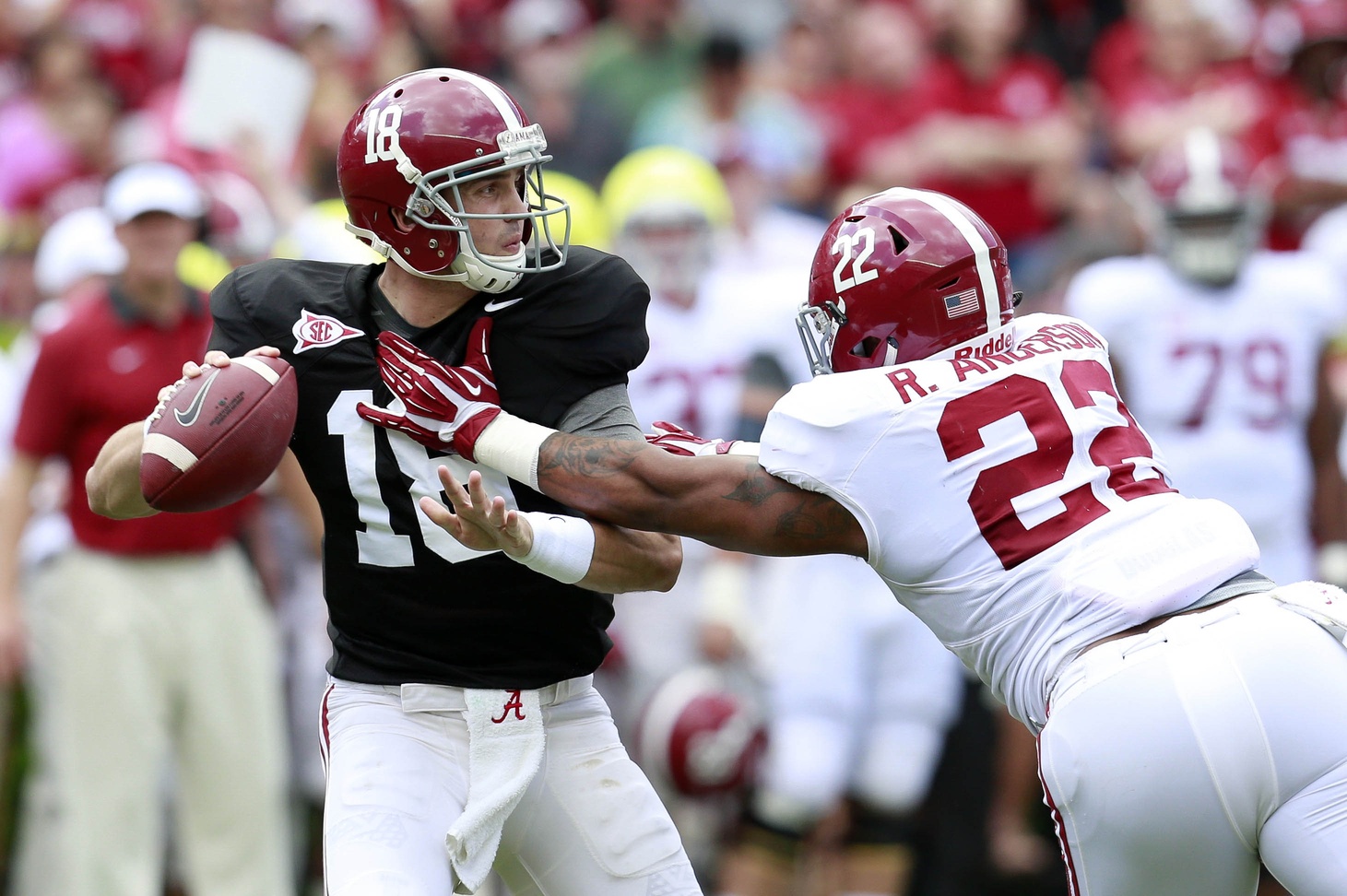
How does path to glory for Alabama’s new QB compare to McCarron, Coker’s?
Alabama’s starting quarterback for this season has yet to be determined, and it won’t be until the fall.
Even when the starter is pegged, that decision is subject to change. After all, last season Cooper Bateman got the nod against Ole Miss before Jake Coker regained the starting job.
The most likely scenario is Bateman wins the job based on experience. In 2011, AJ McCarron earned the starting job and experience played a role. Coker’s experience likely played a role in earning the starting job last season. Alabama has multiple quarterbacks who could ultimately claim the job for good.
While it’s fun to break down the relative strengths and weaknesses of each quarterback candidate, the larger overarching story is that if Alabama wants to win back-to-back national titles, it needs to do so with a new starter at quarterback.
Ten years ago, such a task was viewed as daunting. However, Alabama won the national championship in 2011 and 2015 with first-time starting quarterbacks. Ohio State won it all in 2014 with Cardale Jones at quarterback after Jones began the season as the third-string quarterback.
But how does the situation surrounding this season’s eventual first-year quarterback in Tuscaloosa compare to that of McCarron and Coker’s during their runs to glory?
In 2011, McCarron had a number of key advantages. For one thing, he had an experienced, workhorse running back in Trent Richardson. Also, Richardson’s backup was Eddie Lacy. Richardson shouldered most of the load on offense, carrying the ball 283 times for 1,679 yards and 21 rushing touchdowns.
At the time, Richardson set the school record for most yards and touchdowns in a single season, although Derrick Henry shattered both records in 2015.
McCarron had one of the strongest offensive lines in the country. The team had Barrett Jones at left tackle, D.J. Fluker at right tackle and Chance Warmack at left guard.
McCarron worked under the tutelage of offensive coordinator and quarterbacks coach Jim McElwain, now the head coach at Florida.
On the opposite side of the ball, McCarron had to work against an outstanding defense during practice while also benefitting from having that same defense during games. The defense featured team captains Dont’a Hightower and Mark Barron as well as Courtney Upshaw and Dre Kirkpatrick.
The one major weakness for the team was at wide receiver, a major challenge for a new starting quarterback. Nevertheless, McCarron relied heavily on Richardson and tight end Brad Smelley, two positions typically viewed as safety valves for quarterbacks.
McCarron’s only real big-play threat was Marquis Maze, and it should come as no surprise Maze was Alabama’s leading receiver. It wasn’t until the following season that McCarron was able to more fully demonstrate his abilities with both an added year of experience and a legitimate No. 1 target in the explosive Amari Cooper.
In 2015, Coker had eventual Heisman trophy winner Derrick Henry as the primary running back. Additionally, Kenyan Drake was an effective change-of-pace back with outstanding skills as a receiver, too.
The defense was strong with plenty of depth on the defensive line and the best pass-rush that Nick Saban has had during his tenure. Jonathan Allen led the team with 12 sacks and Tim Williams had 10.5.
The offensive line was not as strong as Alabama has had in recent years but would still qualify as well above average. In particular, Ryan Kelly shined as the leader at center.
The wide receiving corps was solid on the whole but began the season lacking experience. The group made a huge impact by the end of the season. ArDarius Stewart had a number of big plays down the stretch, O.J. Howard had a huge performance in the national championship game against Clemson, and Calvin Ridley set the Alabama freshman record with 1,045 receiving yards.
Coker worked under the tutelage of offensive coordinator and quarterbacks coach Lane Kiffin.
Whoever wins the starting job this season will also work under Kiffin.
This season’s starter lacks the experience in the backfield as Bo Scarbrough and Damien Harris both played sparingly last season. On the other hand, both players were five-star recruits coming out of high school.
Because this wide receiving group is one of the strongest at Alabama, finding a quarterback who makes smart decisions is a big factor. The team returns Ridley, Howard and Stewart from last season, and Robert Foster returns after being sidelined most of last season due to injury.
The defense has plenty of talent back from last season. The biggest difference starts with Jeremy Pruitt replacing long-time defensive coordinator Kirby Smart. Alabama may have lost depth on the defensive line, but the team was bolstered in the pass-rush department by the return of both Allen and Williams. The secondary gained a great deal of experience last season and with a few changes in position, looks stronger.
The offensive line has to deal with the loss of Kelly, which stings and may actually play into the quarterback battle due to leadership and timing snap counts. On the whole, the team should have strong starters on the line, especially projected first-round talent Cam Robinson at left tackle. That said, this season’s offensive line is sorely lacking depth.
So despite a very strong group of pass-catchers, an unproven backfield and thin offensive line — not to mention a brutal schedule filled with tough road games — means whoever wins the starting quarterback job will likely face a tougher path to a national title than either McCarron or Coker.







